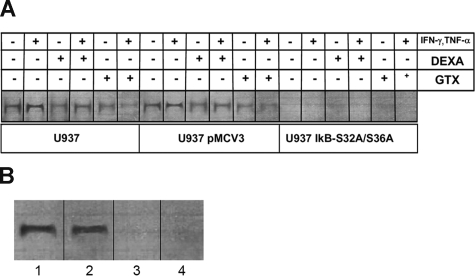Figure 7.
Electrophoretic mobility shift assay of NF-κB binding activity in U937 cells and EBV-transformed B-cell lines. (A) In wild-type (left panels) and pMCV3-transfected (middle panels) U937 cells, induction by IFN-γ and TNF-α caused an increase in binding activity of p50/Rel to an oligonucleotide representing the distant upstream NF-κB site in the CYBB gene. Binding activity was inhibited by dexamethasone (DEXA) or gliotoxin (GTX). No NF-κB binding activity was observed in U937 transfected with the super-inhibitor IκB S32A/S36A, regardless of pharmacological treatment. Representative image, n = 6. (B) Cell lines were derived as follows: lane 1, healthy donor; lane 2, a patient with CGD; and lanes 3 and 4, 2 patients with EDA-ID. Normal B-cell nuclei showed considerable binding activity of p50/Rel to an oligonucleotide representing the distant upstream NF-κB site in the CYBB gene, as also observed in the B-cell line from a patient with X-linked CGD. Reduced formation of the NF-κB complex was observed in B-cell lines derived from the patients with EDA-ID. Representative image, n = 4.

